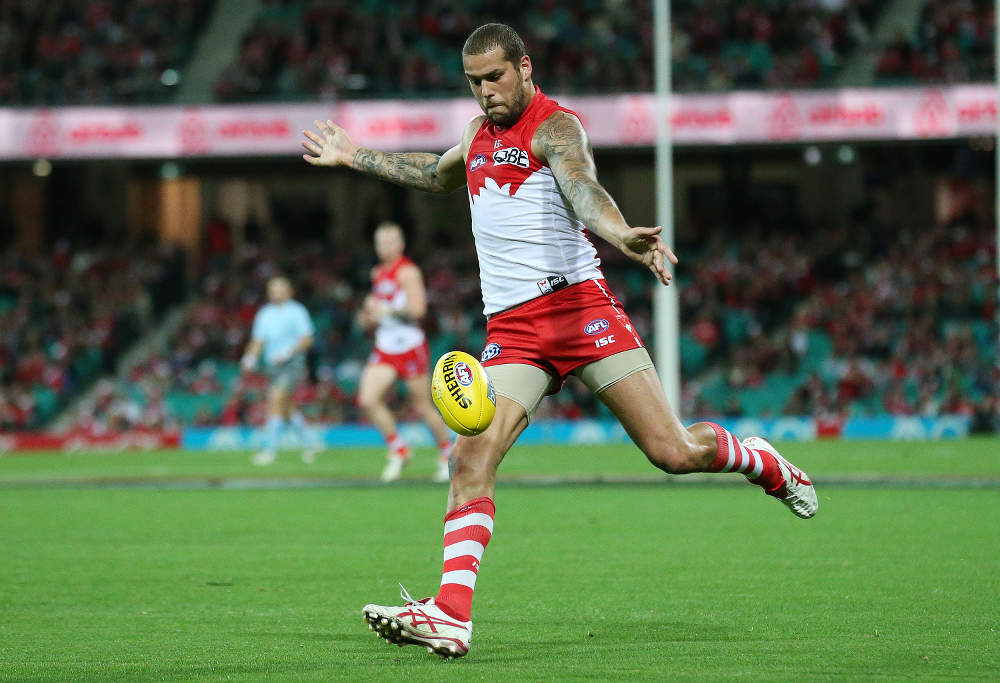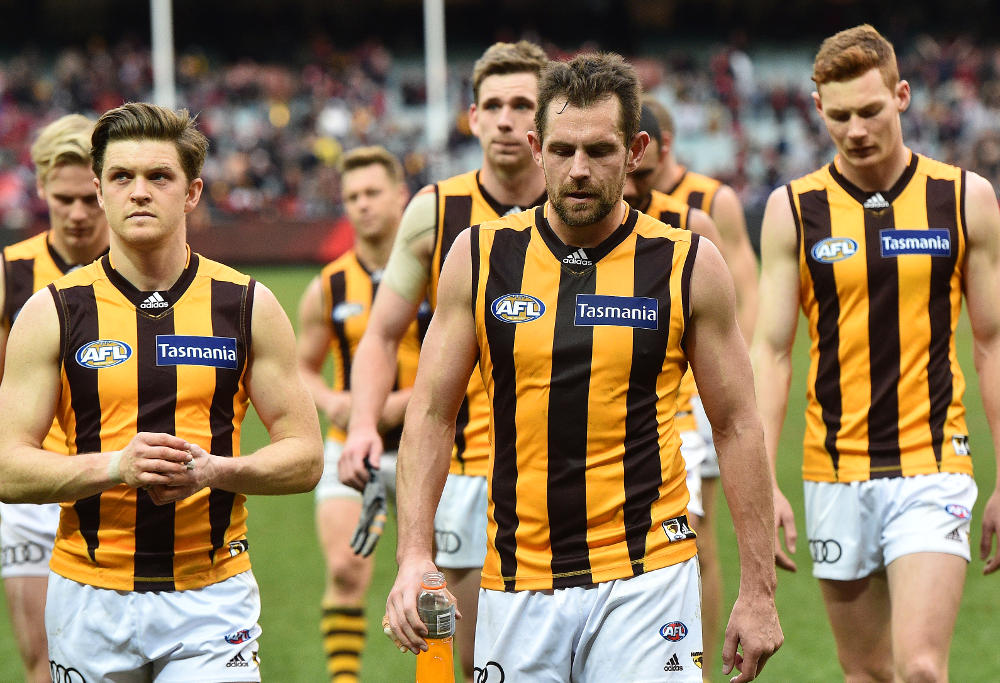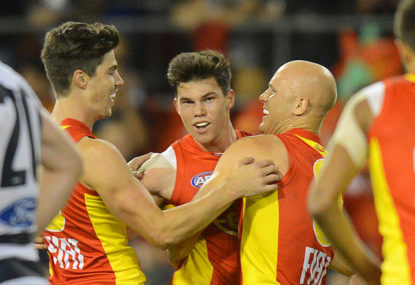Sun rise, sun set. Grand final victors the Western Bulldogs are yesterday’s news in the always-on AFL. The season-within-a-season player-exchange period is well underway, and free agency starts on Friday. Let’s have at it.
The trade period has taken on a life of its own in recent years. There is a daily radio show where punters can call in and wish ill on players who don’t sign with their club just because they can.
Every website, including this one, has club-by-club previews and breakdowns and shopping lists and power rankings. The lure of potential, of what could be, rather than what is, consumes us all in October.
So let’s not do any of that.
We started our off season review on 14 September, looking at what the loss of Jaeger O’Meara and Dion Prestia might mean for the Gold Coast Suns. That was followed by a take on the Hawks, which gave way to a reminder to Geelong fans that once you’re on the treadmill, it is bloody difficult to get off.
That’s how we’ll roll this off season: detailed looks at the most interesting teams and players, rather than the fingernail-deep paragraphs popping up everywhere else.
Bedding down free agency

Free agency has been at play in the AFL since 2012. We’re in the fifth year of operation, and suffice to say the calls that it would destroy the fabric of our game have been proven manifestly incorrect.
As it stands, players qualify for free agency in two ways: a restricted free agent is a player in the top 25 per cent of player payments at his club, who is coming out of contract for the first time after serving at least eight seasons with one club. An unrestricted free agent is a player who has served ten or more seasons at one club.
A restricted free agent’s club has the right to match the tabled offer of a potential suitor for their player, where an unrestricted free agent can move anywhere they’d like. Free agency is also one-and-done: once a player exercises the right to be a type of free agent once, they do not re-earn that right at the end of their contract.
Clubs can be awarded compensatory draft picks for losing free agents according to a formula that is closely guarded at AFL House.
Then there are delisted free agents: players who desire a new contract but have not been awarded one by their current club. They are able to move to the club of their choice in the off season immediately following their delisting, after which they must return through the draft if they want to re-join a list.
The mechanism has proved to be useful, if not revolutionary. 49 players have moved clubs as free agents since 2012, and interestingly, the number is diminishing by the year: 14 in year one, 15 in year two, 12 in year three and just eight last season.
There has been a roughly 50-50 split in moves made by listed versus delisted free agents. So far, the Hawks have been the league’s free agent hunting ground: Hawthorn have lost five players to free regular free agency (Tom Murphy, Clinton Young, Lance Franklin, Xavier Ellis and Matt Suckling), and have acquired just one regular free agent (James Frawley). Melbourne and St Kilda have lost four and three players to free agency respectively, while the rest of the competition has lost two, one or no players.
This year, the number might fall even farther: there are just 25 restricted and unrestricted free agents according to a list compiled by AFL.com.au, and many of these are 30-plus-year-olds with little market value. The biggest fish is Richmond’s Ty Vickery, followed by Fremantle’s Chris Mayne. It’s a shallow pool.
What we’re dealing with now are the dregs of contracts signed in the first year or two of free agency. What’s going on? Without a skerrig of evidence to back this up, I suspect it is because clubs have cottoned on to the notion that signing valuable players up to longer term deals is the smart play when free agency is available.
In the past year alone, there have been five-year-plus deals handed out to all manner of good-to-great players that extend well into their free agency eligibility. Jack Ziebell, Hamish Hartlett, Michael Hurley, Luke Parker, Daniel Talia, Cale Hooker, Steele Sidebottom, Josh Jenkins, Daniel Rich and Tom Scully all signed deals that extend their tenure with their current club through 2021 or later, bypassing free agency service limits and taking them into the latter stages of their respective careers.
It isn’t an across-the-board thing: for every player signed for the long term, there is a player signing to deliberately come out of contract in line with their free agency service limit. But as a rule, it seems that clubs are adopting this strategy.
Player power should be on the agenda

That’s how it should be. But as we’ve seen in recent times, that isn’t always the way it works in practise.
A growing number of players, and mostly young players, are choosing to nominate destinations where they would like to be traded while they are under contract. They are able to do this due to a provision in the AFL collective bargaining agreement which grants all players the right to a trade veto. A player has the final say on a transaction between two clubs, not the clubs themselves.
This right has been included for as long as there has been a CBA as best as I can tell. It is a relic of a past time, where clubs treated semi-professional players as commodities to be bought and sold for transfer fees. The professionalisation and subsequent commercialisation of the AFL, and the increasingly large salaries that players rightly command, have evolved beyond the need for this automatic protection.
The introduction of free agency means the players are largely having their cake and eating it too. This plus the trade veto clause wrests the majority of power that clubs should have in the movement of players across the league. (Click to Tweet)
You wouldn’t know it from reading the papers, but the AFL and the AFL Players Association are deliberating the terms of a new CBA as we speak. As we discussed in February, the CBA is one of the most important documents in the game.
The new agreement was supposed to be reached by June 30 – the player exchange period starts in 48 hours and clubs don’t have any firm idea of the contractual landscape that will confront them over the next six years. The CBA also sets out the salary cap – another important detail that would be nice to know ahead of player trading and free agency decisions.
This thing will be talked about at every single trade meeting between now and October 20, and probably quite frequently thereafter, until it is sorted.
Player power simply must be on the agenda. The AFL’s salary cap is set to surge over the next six-year broadcasting agreement, enriching the players and increasing the incentive for them to chase the best deals possible. The clubs will not be able to manage themselves effectively in this new landscape if players continue to muscle in on list management decisions.
The clubs as a collective should be in a position where they are able to receive the best possible compensation for the loss of their players. Free agency is great, and if the AFLPA get their way it will kick in earlier in a player’s career. The clubs should use this as an opportunity to hack into players’ automatic right to veto trades.
The diminishing value of draft picks

Another issue to consider in this evolving environment is the high value placed on draft picks.
In an environment of much freer player movement, the risks associated with picking 17 and 18-year-olds off of a supermarket shelf are greater. Players with established track records are as mobile as they have ever been, and while for every Shaun Higgins there is likely to be a Colin Sylvia, the draft is no longer the sole source of talent in the AFL.
Then there is the astounding success that teams like the Adelaide Crows, Sydney Swans and Western Bulldogs have had in recent years acquiring talent without tapping into the top end of the draft.
While the Dogs had five top-20 picks in their 22 on grand final day, they also had seven players who began their AFL life on the rookie list or came in through the pre-season draft, and three players taken outside of the top 40 overall. Adelaide have traded or lost through free agency half a team worth of elite talent they initially drafted in recent years, while the Swans are the masters of turning coal into diamonds – albeit they have some pretty flawless pieces to build around.
Between the various forms of free agency, the rapidly improving quality of state leagues, the seemingly increased appetite of players to move around for playing time and success, to unprecedented amounts of data and information about everything in the game, throwing darts at a dartboard one evening in November suddenly doesn’t have the same appeal.
The acquisition task is increasingly about finding talent from every source, not just the draft. And one assumes player development can also play an outsize role in team building.
For some clubs, where talent is sorely lacking and their position on the ladder allows for it, getting younger and hitting up the draft in a meaningful way – multiple high picks in multiple years – is the only path to success. But these clubs will soon become few and far between as the last of the lagging administrators sharpen their pencils or are replaced by good operators from other clubs (look no further than Melbourne for how quickly a good administrator can turn things around).
If everyone’s buying, who’s selling?
When we talked about North Melbourne a month or so ago, I closed that piece by positing that the next two or three years are an excellent time to zig where the rest of the competition zags. The Roos have been found wanting and are in need of some regeneration – now is perfect time for clubs who have been found short of the mark to be selling up.
Of this year’s top eight, only North Melbourne look like they are definitively out of puff. You can make the argument that the Hawks need some time to recuperate, but should they engineer their off season as anticipated, their sojourn may be as short as fortnight of extra rest. The teams from St Kilda through Richmond in 13th should all harbour finals ambitions next season, while Gold Coast and Essendon are wildcards. Carlton showed they have the structure to play ball with the big boys, even if their list remains mired in mediocrity overall.
All of these teams will be looking to get meaningfully better immediately. I’m generalising of course; everyone is going to want to be a net buyer of talent in the aggregate, and they aren’t going to want to give up pieces of value to get better either. It affords the likes of Fremantle, North Melbourne, Brisbane and even Carlton a chance to sell down some of their valuable assets and to have one or two of those deep runs at the draft.
It sets the scene for what looks set to be a frantic player exchange period. As you’re hitting refresh on any one of the 50 fake trade whisper web spinners in the weeks ahead, be sure to keep thoughts of nuance in the back of your mind. There’s going to be plenty of real, meaningful action to keep us busy.
































































































